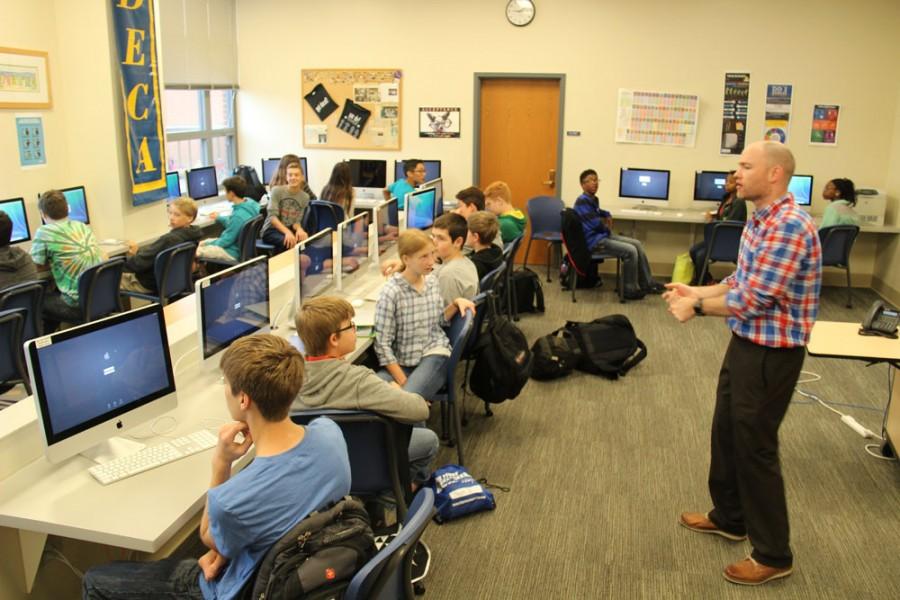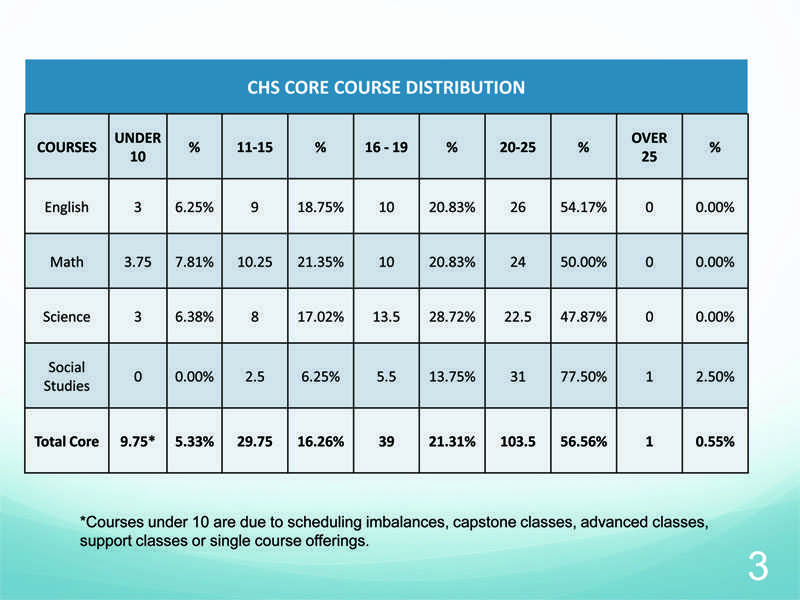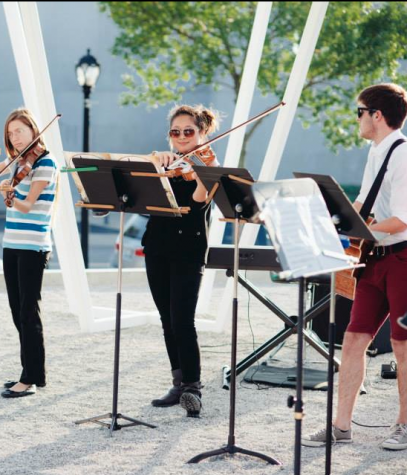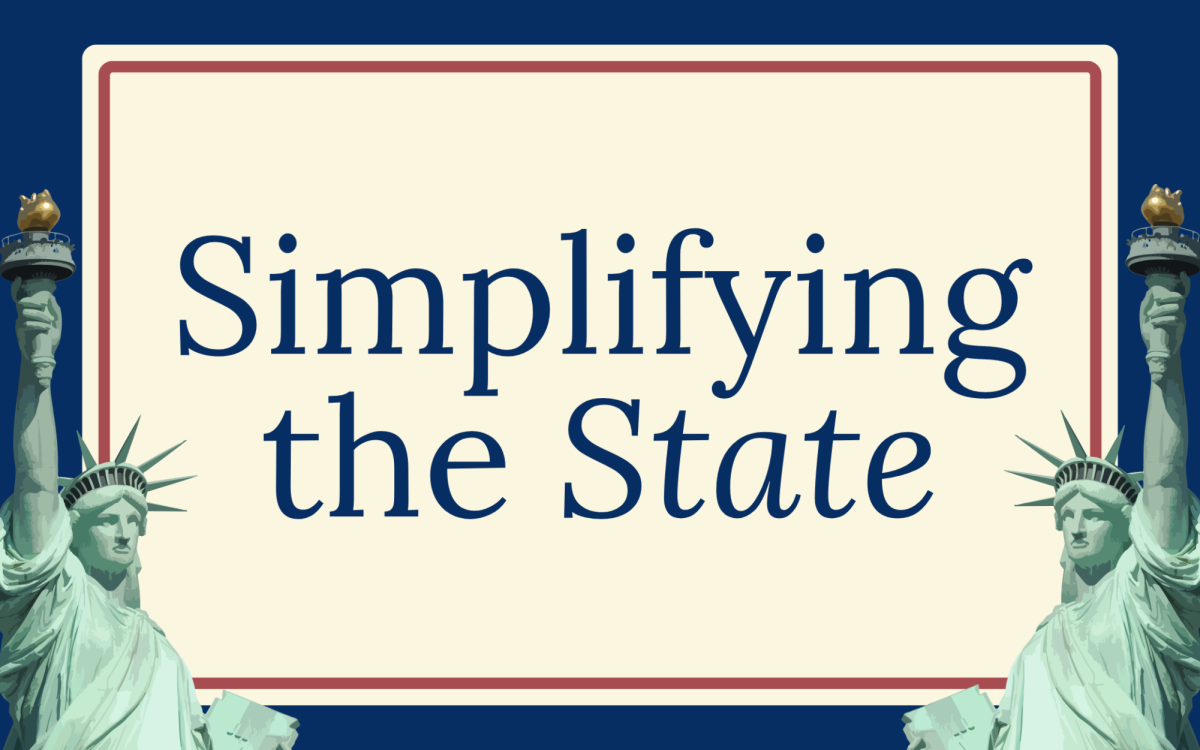A Classy Dilemma
November 6, 2014
Among the 872 students hurrying through the Clayton High School campus is junior Gabby Boeger, on her way to a 24 student honors precalculus class situated in a tight, windowless corner of the school’s first floor. As Boeger descends a flight of stairs to the math wing, she traces the path senior Malik Hadjri took to his advanced placement French class last year. However, his destination was a little different. As he unpacked his books and began class, he was one of only five students in the room.
The issue of class size disparity has risen to the forefront of students’ attention as more and more classes bear the evidence of its effects.
Initially brought about by rising student enrollment, shifting student interests, scheduling conflicts and limited resources, CHS class sizes pull against the boundaries of the reported mean class size of 20 students.
According to enrollment and class size reports presented to the Clayton Board of Education, CHS building enrollment has steadily increased over the past three years, from 844 students during the 2012-2013 school year, to 870 students the next year. This year, there are 872 students enrolled at the high school.
Clayton BOE Vice President Kristen Redington offered her explanation for the increase in enrollment.
“We have a great reputation worldwide. When you have people coming from other countries that are coming to work at Wash-U, they know about Clayton,” Redington said. “They know our reputation and they want their kids to come here.”
Along with increases in Clayton’s residential population, the Clayton School District provides additional enrollment for statutory tuition, board grants and Voluntary Transfer Students. Increasing grade sizes, although not the sole driving force of class size increase, can significantly change classroom environments.
As the influx of students increases, the amount of resources available does not necessarily change to accommodate the heightened need. Thus, one result is increasing class sizes.
In addition to rising enrollment, Counseling Services Director Carolyn Blair believes that rigidity in scheduling has also affected the widening disparity and increase in class size.
“Class size have changed based on the fact that our schedule is tighter. Fewer teachers means fewer classes, fewer classes overall creates less give in the schedule. We notice this in the counseling office because it has become more difficult to change students’ schedules,” Blair said. “When classes are set right at our cap, it creates imbalance when there is movement.”
The class size cap is currently loosely set at 24 students. Although there are not many classes that go over the School Board’s suggested cap, many are set right at 24.
By far the largest classes are the P.E. and health classes. During the 2013 to 2014 school year, health and P.E. teacher Darby Hogan had 33 students in one classroom.
“Class sizes were supposed to be capped last year at 30 students; however, in order to meet the graduation requirements, additional students were added, resulting in a class size of 33,” Hogan said. “[The counselors and administration] are working hard to schedule students in the classes they need in order to graduate, and it is sometimes difficult when there is limited space. This year has been great with no classes over 29 students.”
Despite the necessity for some large classes, spacing issues have occurred. Department Chair of Physical Education Barry Ford has felt the effects of these decisions.
“Classes like racquet and net sports get really overrun because we can only hold so many students per court. I think about 24 is probably the max, but we have 29, 30, sometimes 31 [students]. I then have to create other activities for the overflow of students. Otherwise, they would be standing around, waiting for the opportunity to participate,” Ford said.
P.E. and health classes are not the only ones being affected by the class size increase. According to enrollment and class size reports from 2013, approximately 57 percent of core classes had 20 to 25 students. Social studies courses rank the highest for number of students, with about 78 percent of social studies classes containing 20 to 25 students.
Student Effects
The consequences of such large class sizes are not limited to the need for more physical space. Class sizes influence the comfort and security students feel in their classrooms.
Director of Learning Center and Academic Support Carroll Lehnhoff-Bell believes that smaller class sizes can promote positive student teacher connections.
“There is a great deal of research around the benefit of having a relationship with a teacher,” Lehnhoff-Bell said. “A student is much more likely to ask a question if said student has some sort of relationship with that teacher. If you have a class size of 30 or 40, can that happen? That relationship either takes twice, three or even four times longer to develop, or it never does because a student is just a number.”
Larger class sizes can affect the quality of student-teacher relationships. In contrast, a comfortable classroom environment where the teacher recognizes the student as an individual may give students the confidence to take more risks. Junior Sonya Liu believes that her learning is affected by the amount of attention she receives from her teacher.
“I’ve found that in classes where there are a lot of people, if the teacher doesn’t pay attention to me that much, I care less. So, I will sometimes doze off during class,” Liu said. “I consider myself a pretty good student, but sometimes, when you’re surrounded by that many people, you just want to sleep.”
Although unique for every individual, many students believe that smaller class sizes promote better learning.
Having been in a five student AP French class his junior year, senior Malik Hadjri is familiar with the intimate atmosphere common to smaller classrooms.
“[AP French] was the smallest class I have ever had at Clayton,” Hadjri said. “You can be really involved in the class and you can learn a lot really quickly. But, if you are having an off day and don’t really want to talk to anybody, well, you are one-fifth of the class, so you can’t just put your head down if you’re tired.”
In addition to his enhanced motivation and attentiveness during class, Hadiri believes that he developed a closer relationship with his AP French teacher due to the reduced class size.
“I feel like I got to know my teacher way better. With Madame Hartmann, half the class was a conversation,” Hadjri said.
Hadjri is not alone in appreciating the efficiency and productivity of smaller classes.
“I think a smaller class means […] a better chance of being involved and engaged,” Boeger said. “It’s really different being in a large math class. I sit in the front so I have a better chance of retaining the information. It’s challenging to focus because I can hear lots of conversations going on in the background.”
However, there are benefits to larger classes. Although sometimes distracting, Boeger recognizes the diversity of her math class.
“I like that there are lots of different people because it helps the morale of the classroom. People are excited about math, which helps the energy of the classroom,” Boeger said.
Administrative Decisions
The size of a class involves numerous administrative decisions.
The BOE is responsible for outlining and voting on the policy that dictates class size. Members of the board are largely in support of maintaining Clayton’s renowned small class sizes.
“When you go off to college and you are in a classroom of 50 or 100 or 200, you are not going to have the same experience or learning opportunity as you did your senior year in Clayton High School,” Redington said. “We are all focused on smaller class sizes. It is important to the community and we are the voice of the community.”
However, determining policy is not entirely based on the board members’ educational desires. Sometimes administrators must make decisions in response to the growing trends and numbers of the school.
“You can’t control our residential population,” Redington said. “If our residential population goes up for any reason, then you may have more kids in a grade than you had before.”
Three years ago the board shifted from using target class sizes to a standard figure. Originally, class sizes were supposed to be between 20-25. Classes typically fell on the low end of this scale.
As of October 2011, the number shifted to a standard class size of 22 for the high-school. Although not treated as a hard cap, 24 students became the desired maximum.
Principal Dr. Dan Gutchewsky and Assistant Principal Ryan Luhning work together to determine yearly class sizes.
They keep the 22 standard in mind, yet sometimes the complex process yields varying outcomes. Certain classes that used to split at around 24 now might not split.
Tobie Smith, 12th grade level counselor, works closely with other administrators to handle student-desired changes in schedules.
“Whether it was Dr. Gutchewsky or Mr. Luhning, we have conversations pretty much daily,” Smith said. “They might have already thought through it, but I just give them other things to think about.”
Smith and the other counselors do not have an easy job. Clayton aims to be extremely open to schedule changes. In some cases, this can be to a fault. Often times, a student unprecedentedly moving into different classes creates visible size disparities. If the number of students falls below 10, administrators are less likely to keep the class around.
“Financially, it doesn’t always make sense,” Smith said. “When you run that many classes of 10, that one teacher can only teach that class, they can’t teach another.”
Nonetheless, as of 2013, around 10 percent of special area classes were under 10. Many of these numbers are unavoidable, yet they make the dilemma of class size disparity all the more difficult to approach.
From an outsider’s perspective, the addition of one or two students does not seem like a problem.
Assistant Superintendent of Human Resources Sean Doherty said, “Class sizes will always fluctuate a little bit from year to year, most of which is caused by increases or decreases in enrollment as opposed to reducing the number of teachers in the District. If you look at class sizes over an extended period of time, they are fairly consistent with the guidelines we had in place at the time.”
Teacher Strategies
“I think anybody in the building sees the class size difference,” Elizabeth Caspari, French teacher and Foreign Language Department Chair, said.
As class sizes fluctuate, teachers must also adapt to varying classroom environments. Sometimes these adaptations can be detrimental to student-teacher relationships.
Changing class sizes mean different things for each department.
The CHS English department is well known for its unique and individualized conference system. However, with large class sizes, teachers are strained in the height of a full conference cycle.
“I’ll have at least one conference nearly every hour that I’m not teaching. I may have one period off, but generally I’ll have seven a day, eight sometimes,” English teacher John Ryan said.
Often times, teachers must conference before and after school to fit in planning periods during the day. Occasionally, conferences can bleed into the weekend. When the conference program was created nearly 40 years ago, Clayton had a much smaller enrollment and thus smaller class sizes.
“As a model, it was designed around 16 students in a class. So now with classes of 22, 23, that’s easily an extra day’s worth of conferencing,” Ryan said.
Often times, the effects of large class sizes result in significant problems. The foreign language department is home to many larger classes, primarily in introductory language levels The department, which had five classes outside of the desired class-size range last year, has been unable to use school resources because of their class sizes.
Foreign language teachers use the high school’s language lab nearly once a week. Although administrators have made plans to replace the lab in upcoming years, current usage can be difficult. As few as 20 computer stations work, and with classes sizes of 25, select groups can no longer utilize this learning resource.
However, in response to changing class sizes, teachers have adapted. Caspari has noted these subtle changes.
“Somebody who used to give a test back in one day and give immediate feedback, now it’s almost immediately, and back in two days,” Caspari said. “The average student won’t notice. The teacher might notice, though.”
However, students do notice their relationship with their teacher. Smaller class sizes mean more one-on-one time with students. These valuable relationships, a guiding point in Clayton’s educational mission, are harder to create in classes nearing 25 students.
Caspari noted ways in which she works to create relationships with her students in larger classes.
“For these I’ve got them [students] writing about themselves. I try and go and sit with them, and I still feel a little behind,” Caspari said. “It might be that our box of tricks needs updating because we haven’t done this as much.”
In larger classes, teachers may need to compensate for an overwhelming number of bodies. And while adaptations are good, at what point does the strain on teachers become overwhelming?
The language teachers are determined not to falter in their excellence, but the effort can be taxing.
“[The language teachers] still feel the Clayton commitment to individualization, but they find it incredibly hard to do,” Caspari said. “There hasn’t been a shift in our expectations. We don’t say, ‘Oh, let’s skip the research project.’ They are as driven as the students are. They are trying, and sometimes they are trying too much.”
Some teachers do not note a difference in their teaching styles when classrooms fill to the brim. History teacher Samuel Harned characteristically has large AP U.S. and European history classes. His classes are generally lecture-style, and a few more students do not change the quality of his teaching.
“Last year I had a 28 [student] AP US class. That’s not anything the administration forced me into, I freely allowed people to come in because they wanted to take the course and I had a hard time saying, ‘No, you can’t take it,’” Harned said.
While Harned’s teaching style might not be greatly affected by a larger number of students, many teachers have needed to change their approach. Director of Teacher Education and Academic Services at Washington University Professor Ron Banfield commented on why a teacher’s style might change.
“Every additional individual in that classroom is an additional individual that I, as a teacher, need to think about. I need to measure their progress and, as best as I can, individualize some instruction for them,” Banfield said.
There are different ways for teachers to tackle growing class sizes. Sometimes these strategies come at a cost of a student’s educational experience.
“You teach a small class one way, and you teach a large class another way,” Caspari said.
Standard of Education
Clayton is known nationally for its academic excellence, and such recognition comes from more than simply test scores.
“‘Think deeply and carefully.’ That’s my philosophy of education, and, I think, every subject area has some component of that … There’s a level that might be lacking from a public school if we’re not taking on the big questions of what it is to live as a human being,” Ryan said.
Teachers from all departments at CHS echo Ryan’s sentiments. Unlike many surrounding public schools, the District has the resources and academic commitment from parents to pursue such ambitious educational goals.
However, the nature of the school’s educational philosophy does not change the nature of the school. Clayton is a public institution, and comparing the school’s profile to surrounding schools, especially concerning class size, can put administrators in a tricky situation.
“We’re in public education,” Smith said. “If a kid shows up, we’re going to educate them.”
Neighboring private schools do not deal with such concerns; however, it is to these schools that CHS is often compared with.
“The expectation is private school service in a public school setting,” Blair said.
Compared with other public schools, Clayton does quite well.
“At Kirkwood they have hard class caps at 28 or 29. My wife teaches at Ladue. She’s an English teacher and she regularly has class sizes in her core classes that approach 30,” Gutchewsky said. “We are very fortunate to have the class sizes that we do, particularly in our core classes.”
As reported by the Missouri Department of Elementary and Secondary Education, standard class sizes in Missouri are 33 students. The department also cites 24 students as being the desirable class size, a size that is common throughout CHS.
However, despite the facts, Clayton is not the typical public school. When concerned with academic performance, CHS is often likened to neighboring private schools. Once again, comparisons between schools are not easy.
Blair noted the discrepancies in Clayton’s choices of competition.
“The schools that we are being compared to change based on what the conversation is. Usually in terms of college we are being compared to Burroughs, and MICDS, but when it comes to class size or case load, we’re being compared to Lindbergh and Kirkwood,” Blair said.
Ultimately, CHS must focus on carving out a unique niche amidst competing schools. Instead of focusing on the schools that may not be receiving stellar reviews, or even schools struggling with accreditation, many teachers suggested that Clayton continues to look for competition.
“When comparing Clayton to other schools, I like to look at other high performing schools where kids are doing great things and achieving great things,” Lehnhoff-Bell said. “That is who I want to compare us to. If their class sizes are big that is one thing, but if their class sizes run on the smaller side than that’s another thing.”
Conclusion
“Depending on class size, a teacher might be operating on one of three different levels,” Lehnhoff-Bell said. “At one level it can be about the learning, at another level it is about the teaching, and at another level you are managing the class. For maximum student learning, I’d like to be able to operate as a facilitator, rather than a manager.”
There may not be one perfect class size to guarantee the optimal classroom environment. Determining the right amount of students for one class depends on a variety of factors, including the quality of the teacher, the teaching style, surrounding support structures in place for students, and the academic ability of each student.
However, most teachers have an idea of what works for them. Unfortunately, at Clayton and at a national-level, teachers get very little say in the number of students in their classrooms.
While there is no one solution to the dilemma, Blair shared one idea to decrease the disparities between class sizes.
“Teachers should set the ideal class size,” Blair said. “It may be different for one discipline, or for one particular class than another, but I wouldn’t presume to tell them how many students they should be able to teach. I think that teachers should be able to say, ‘This is what’s ideal for what you’re expecting of me out of this class.’”
Ultimately, the conversation concerning class sizes may never reach an end. As the district’s goals develop, differing opinions concerning class sizes will arise. One can only hope that new developments always have both the students’ and teachers’ educational experience in mind.
The students in these classes are the ones directly impacted by the decisions of the district. Boeger will still have to struggle to concentrate in a class at its full capacity, while Hadjri can fondly look back upon his tiny French course.
Hopefully, all students get a chance to experience joyful learning, in whatever form it comes in. The district must keep the conversation about class sizes a priority.
Redington may have said it best: “If you are staying the same then that is not world-class. World-class means that you are always evolving and that you are always trying to reach that next target.”










